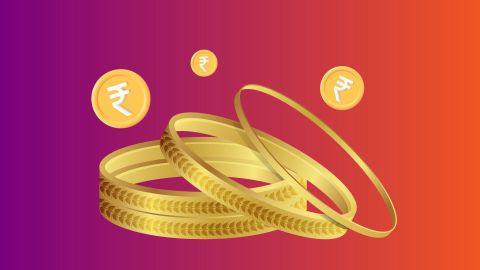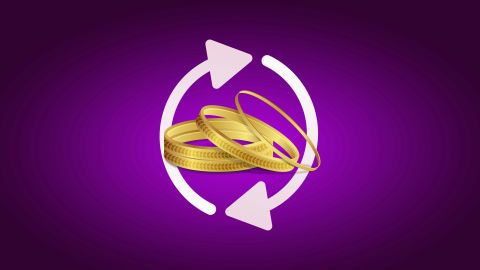2 mins
10 December 2024
Nordic Gold, despite its name, is not real gold. It is a copper alloy with a gold-like appearance and has become a popular material in various applications. Known for its durability, corrosion resistance, and aesthetic appeal, it is frequently used in coinage and other industrial uses. Understanding its composition, uses, and differences from traditional gold is essential for evaluating its significance and its role in financial products like gold loans.
The composition and properties of Nordic gold
Nordic Gold is a copper-based alloy composed of 89% copper, 5% aluminium, 5% zinc, and 1% tin, designed to mimic the appearance of gold while being more affordable. Despite its name, it contains no actual gold. This alloy is prized for its bright gold-like appearance, high durability, and resistance to corrosion. It is also non-allergenic and lightweight, making it suitable for a variety of applications.
Nordic Gold is particularly popular in coin production due to its hardness and resistance to wear and tear, ensuring long-lasting performance. Its cost-effectiveness and ability to replicate the luxurious look of gold make it a preferred choice in industries that require an elegant aesthetic without the expense of real gold. Beyond coins, it is used in industrial applications where durability and affordability are key. Nordic Gold balances practicality and appearance, making it a versatile material for modern use.
One major difference lies in affordability. Nordic gold is much cheaper than traditional gold, making it a cost-effective choice for industries like coin production. It is also harder and more durable than traditional gold, which is a softer metal prone to scratches and wear.
Additionally, Nordic gold is non-allergenic and resistant to corrosion, making it ideal for everyday use in coins and industrial applications. Traditional gold, though valued for its purity and intrinsic worth, is less practical for such purposes. Nordic gold offers the aesthetics of gold without the high cost or limitations of the real metal.
Nordic Gold is particularly popular in coin production due to its hardness and resistance to wear and tear, ensuring long-lasting performance. Its cost-effectiveness and ability to replicate the luxurious look of gold make it a preferred choice in industries that require an elegant aesthetic without the expense of real gold. Beyond coins, it is used in industrial applications where durability and affordability are key. Nordic Gold balances practicality and appearance, making it a versatile material for modern use.
Common applications of Nordic gold in coinage
Nordic Gold is widely used in coinage due to its durability, affordability, and resistance to tarnishing. Many modern coins, including the Euro, are made from Nordic Gold because it can withstand frequent handling and maintain its appearance over time. Its gold-like shine adds aesthetic appeal, making it ideal for commemorative and circulating coins. Additionally, Nordic Gold’s corrosion resistance ensures that coins retain their quality in various environmental conditions. The alloy’s non-allergenic properties make it safe for use, while its low cost compared to real gold helps governments produce coins economically. Its widespread use in global currency highlights its practicality and effectiveness in coinage.Why Nordic gold is different from traditional gold?
Nordic gold is distinct from traditional gold in its composition, properties, and applications. Unlike traditional gold, which is a natural precious metal, Nordic gold is an alloy made from 89% copper, 5% aluminium, 5% zinc, and 1% tin. It contains no actual gold despite its bright, gold-like appearance.One major difference lies in affordability. Nordic gold is much cheaper than traditional gold, making it a cost-effective choice for industries like coin production. It is also harder and more durable than traditional gold, which is a softer metal prone to scratches and wear.
Additionally, Nordic gold is non-allergenic and resistant to corrosion, making it ideal for everyday use in coins and industrial applications. Traditional gold, though valued for its purity and intrinsic worth, is less practical for such purposes. Nordic gold offers the aesthetics of gold without the high cost or limitations of the real metal.
What is the difference between gold and Nordic Gold?
| Aspect | Gold | Nordic Gold |
| Composition | Pure gold or gold alloys | Copper alloy with no actual gold content |
| Value | High intrinsic value | Value based on functionality and properties |
| Durability | Soft and malleable | Hard and corrosion-resistant |
| Applications | Jewellery, investments, coins | Coins, industrial uses, decorative purposes |
| Appearance | Natural yellow lustre | Gold-like appearance |
| Cost | Expensive | Cost-effective |
How to make Nordic gold?
Making Nordic Gold involves alloying specific proportions of copper, aluminium, zinc, and tin. First, 89% copper is melted as the base material, followed by the gradual addition of 5% aluminium, 5% zinc, and 1% tin. These metals are blended under controlled temperatures to ensure a uniform composition. The molten alloy is then cast into desired shapes or sheets, depending on its application. Once solidified, the material can be further processed, polished, or shaped into coins or decorative items. The resulting alloy mimics gold’s appearance while offering enhanced durability and affordability, making it suitable for a wide range of uses.Uses of Nordic Gold
Nordic Gold is used in various industries due to its durability and gold-like appearance. Its primary application is in coinage, where it is favoured for its corrosion resistance and low cost. The Euro’s smaller denominations are made from Nordic Gold, highlighting its suitability for currency. It is also used in medals, decorative items, and industrial components requiring lightweight and non-corrosive materials. Nordic Gold’s non-allergenic properties make it safe for items in frequent contact with skin. Its affordability compared to real gold allows it to replace gold in aesthetic applications without compromising appearance. This versatility ensures its continued demand across industries.Impact Nordic gold on gold loan
Nordic Gold does not impact gold loans directly, as it contains no actual gold and lacks intrinsic value. Gold loans are typically granted based on the purity and weight of genuine gold, making Nordic Gold ineligible as collateral. However, its affordability and gold-like appearance can benefit industries requiring cost-effective alternatives to real gold. Bajaj Finance assesses gold items based on their certified purity to determine the loan amount. Since Nordic Gold does not meet these criteria, it cannot be used for financial products like gold loans. This distinction underscores the importance of genuine gold in collateral-based financial transactions.Frequently asked questions
Is Nordic gold real gold?
No, Nordic gold is not real gold. It is a copper-based alloy composed of 89% copper, 5% aluminium, 5% zinc, and 1% tin. Despite its gold-like appearance, it contains no actual gold. It is designed to mimic the colour and look of gold while offering cost-effective and durable properties. Nordic gold is commonly used in coinage and industrial applications due to its affordability and corrosion resistance.
What is Nordic gold used for?
Nordic gold is primarily used in coinage, with many modern coins, including the Euro, made from this durable and corrosion-resistant alloy. Its gold-like appearance and affordability make it ideal for commemorative coins, decorative items, and industrial components. Additionally, Nordic Gold’s non-allergenic properties make it suitable for objects in frequent contact with skin. Its versatility ensures its widespread use across various industries requiring cost-effective alternatives to real gold.
Does Nordic gold rust?
No, Nordic gold does not rust. Its composition, which includes 89% copper, 5% aluminium, 5% zinc, and 1% tin, provides excellent corrosion resistance. This property makes Nordic gold ideal for coinage and other applications exposed to varying environmental conditions. While it does not rust, it may develop a patina over time due to copper content, enhancing its aesthetic appeal without compromising durability or structural integrity.
How tough is Nordic gold?
Nordic gold is highly tough and durable due to its copper-based composition. Its hardness surpasses that of real gold, making it resistant to wear and tear. This toughness ensures its long-lasting performance in coinage and industrial applications. Nordic gold is particularly valued for its ability to withstand frequent handling, exposure to environmental factors, and mechanical stress, making it a reliable material for items requiring both strength and aesthetic appeal.
Show More
Show Less
Bajaj Finserv App for All Your Financial Needs and Goals
Trusted by 50 million+ customers in India, Bajaj Finserv App is a one-stop solution for all your financial needs and goals.
You can use the Bajaj Finserv App to:
Apply for loans online, such as Instant Personal Loan, Home Loan, Business Loan, Gold Loan, and more.
You can use the Bajaj Finserv App to:
Apply for loans online, such as Instant Personal Loan, Home Loan, Business Loan, Gold Loan, and more.
- Explore and apply for co-branded credit cards online.
- Invest in fixed deposits and mutual funds on the app.
- Choose from multiple insurance for your health, motor and even pocket insurance, from various insurance providers.
- Pay and manage your bills and recharges using the BBPS platform. Use Bajaj Pay and Bajaj Wallet for quick and simple money transfers and transactions.
- Apply for Insta EMI Card and get a pre-approved limit on the app. Explore over 1 million products on the app that can be purchased from a partner store on Easy EMIs.
- Shop from over 100+ brand partners that offer a diverse range of products and services.
- Use specialised tools like EMI calculators, SIP Calculators
- Check your credit score, download loan statements, and even get quick customer support—all on the app.






